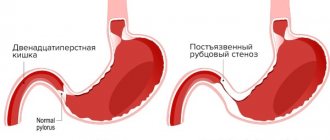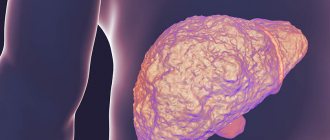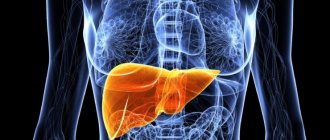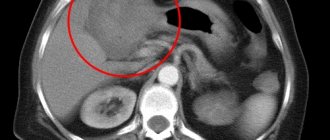Cirrhosis is usually called pathological changes in liver cells, which are accompanied by impaired circulation in the vessels and bile ducts.
Basically, cirrhosis develops against the background of chronic hepatitis, and the risk group includes men aged 45 years and older. Recently, the disease has become diagnosed a little more often, but it still accounts for only 8% of the total number of liver lesions.
In 70% of cases, cirrhosis develops against the background of hepatitis C, and the worst thing is that the pathology is asymptomatic for a long time. Slightly less frequently, cirrhosis is caused by autoimmune and toxic hepatitis, fatty steatosis, and heart failure. Therefore, there are two categories of cirrhosis, which are classified according to the cause of their occurrence: primary and secondary.
How long do people live with stage 1, 2, 3 and 4 cirrhosis?
Unfortunately, it is impossible to completely cure liver cirrhosis in the last two stages, but you can improve the quality of life.
Cirrhosis goes through 4 stages in its development:
| First stage (compensation) | Accompanied by an inflammatory process, weakness, decreased performance, loss of appetite. The average life expectancy at this stage is about 6-7 years. |
| Second (subcompensation) | It becomes more serious and severe, because the person begins to experience constant vomiting and nausea, and an increase in temperature. The patient has dark urine and white feces, jaundice, and pain in the right side. If treatment is prescribed at the second stage, then you can live with cirrhosis for no more than 5 years. |
| Third stage (decompensation) | Leads to the development of such dangerous complications as hepatic coma, carcinoma, thrombosis, pneumonia. Spontaneous, causeless bleeding and sepsis often occur, accompanied by fever, vomiting, muscle atrophy and persistent diarrhea. The patient has no chance for a long life, and he dies within 3 years, even with proper treatment. |
| Fourth (terminal) | The stage is considered the last, with a life expectancy of about six months. At this stage of the development of the disease, the liver completely decomposes, deformation and physiological changes of all internal organs occur. |
The main thing is to strictly follow all the doctor’s instructions and recommendations, and reconsider your habits and lifestyle.
Dependence on the stage of pathology
Pathological destruction of the liver has four stages of development: compensated, subcompensated, decompensated and terminal. The initial stage of development or compensated cirrhosis is not distinguished by vivid manifestations of symptoms. The disease can be determined using blood microscopy or ultrasound diagnostics. The compensatory mechanism works intensively in the body; healthy hepatocytes work with double the load, trying to perform the functions of the affected cells.
External manifestations of complications of liver cirrhosis
As a rule, there are no significant complications. With timely detection of pathology and effective therapy, life expectancy can reach one and a half decades. Sudden death within a year is no more than 1%. If esophageal varicose veins develop already in stage 1 of the disease, rapid death occurs in 4% of cases. Subcompensation of the disease or the second stage of development is characterized by pronounced symptoms of liver cirrhosis:
- heaviness in the epigastrium (epigastric region), nausea, regular release of vomit;
- dysania (sleep disorder), fatigue, low ability to work;
- psychovegetative disorders: asthenia (neuropsychological weakness); ataxia (impaired coordination of movements), memory disorder, lack of ability to concentrate, indifferent attitude to external events;
- alternating constipation (constipation) and diarrhea (diarrhea);
- intense gas formation and bloating;
- pain in the right hypochondrium.
Prospects and influencing factors
The main factors influencing the course of the pathology:
- gender and age of the patient;
- stage of the disease;
- compliance with all medical recommendations;
- reasons for the development of the lesion;
- the presence of concomitant diseases and complications.
The strength of the immune system and the patient’s refusal of bad habits and food addictions play a significant role. Thus, older patients die much faster and more severely than younger ones.
However, young people are more likely to suffer from cirrhosis caused by excessive use of alcohol and drugs. Gender also influences the course of the pathology, and women get sick more severely and die much faster than men.
Gender and age criterion for life expectancy
The main category of patients with liver damage are people aged 40+. At this point, a person often has chronic pathologies of some organs and systems, so the body is not able to cope with cirrhosis. In addition, protective forces (immunity) tend to decline with age. Even colds are more difficult to bear than in youth. In the case when cirrhosis is diagnosed at the age of 60+, there is practically no chance of living for more than 3 years.
Etiological classification
From an etiological point of view, the main causes of cirrhosis are viral infection and alcohol intoxication. It has been proven that the disease can be triggered by protein deficiency in the body, poor diet and lack of essential vitamins.
According to the etiological classification, there are:
- autoimmune cirrhosis;
- genetic;
- alcoholic;
- cryptogenic;
- toxic;
- biliary;
- viral;
- cardiac.
The most common are toxic and biliary cirrhosis. These varieties are considered less dangerous and less likely to lead to dangerous complications. According to the morphology of the disease, it is customary to distinguish macrono-micronodular and mixed cirrhosis.
Liver cirrhosis stage I
At this stage, the patient often has no idea about the development of the pathology and does not experience negative feelings. Sometimes, when drinking alcohol or eating unhealthy (fatty and spicy) foods, you may experience slight heaviness under the ribs, a bitter taste and dry mouth, and signs of mild dyspepsia.
However, these signs are an alarming signal of the onset of an inflammatory process, leading to the formation of fibrous areas that separate the healthy parts of the liver from the affected ones.
Simultaneously with inflammation, fatty degeneration of cells occurs in the liver, preventing the normal functioning of blood vessels.
Moreover, the first pattern of disease development is typical for men, especially those who abuse alcohol, and the second - for women who do not adhere to healthy eating standards. The main condition for prolonging life is timely diagnosis, which is carried out using a liver biopsy or biochemical analysis.
Cirrhosis II degree
If the patient does not consult a doctor in a timely manner, continues to lead an unhealthy lifestyle, eat poorly and drink alcohol, then very soon the disease moves into the second stage.
At the same time, liver cells begin to break down faster, leading to the appearance of unpleasant symptoms. Connective scar or fatty tissue rapidly grows, covering an increasingly larger area, leading to necrosis. This process is already irreversible.
The doctor must prescribe medications that prevent the proliferation of connective tissue, as well as hepatoprotectors. Therapy is carried out under medical supervision, with regular monitoring of the condition of the organ.
Liver cirrhosis stage III
Further, the disease begins to progress, leading to the development of liver failure. Bilirubin in the blood reaches a record level of 60 units, and the amount of albumin decreases sharply.
This condition is accompanied by poor circulation, varicose veins of internal organs, and hypertension. The patient requires an emergency liver transplant, otherwise his life will be a maximum of 3 years.
After the operation, the prognosis is quite optimistic, i.e., if you follow the instructions, regularly take various heavy medications, give up unhealthy foods and habits, the person is able to live fully for another 10-15 years.
Treatment tactics for subcompensated cirrhosis
At the early stage of cirrhosis, pathological changes in liver cells can be subcompensated by correcting the patient’s lifestyle - adhering to the principles of a healthy diet, giving up harmful individual habits, as well as normalizing the work and rest regime.
In general, with compensated cirrhosis, it is imperative to follow an integrated approach to drawing up a treatment plan:
- etiotropic therapy - antiviral or antibacterial agents;
- pathogenetic effect - taking immunosuppressive drugs for autoimmune cirrhosis or a decrease in the concentration of copper in the parenchyma of the organ;
- symptomatic treatment - elimination of manifestations of liver failure, for example, encephalopathy, portal hypertension.
In order to maintain the activity of hepatocytes in the subcompensated form of cirrhosis, courses of hepatoprotectors, choleretic agents, as well as antioxidants and diuretics will be additionally recommended. It is absolutely unacceptable to independently change the hepatologist’s prescriptions - doses, frequency of medication and duration of therapy.
Traditional medicine - decoctions and infusions/tinctures with medicinal plants, for example, milk thistle, tansy, Solyanka, immortelle, successfully complements basic treatment. However, recipes for improving liver function with plant extracts should not replace it, so as not to aggravate the disease.
Life expectancy in primary biliary cirrhosis
Biliary primary cirrhosis is called liver damage due to autoimmune pathologies. Hepatocytes are replaced by connective tissue, bile outflow is disrupted, and the bile ducts are completely blocked (cholestasis).
It is difficult to name the exact reasons for the development of the disease, but most likely it could be viral, autoimmune diseases, hormonal changes, and heredity.
The only symptom by which the disease can be recognized at an early stage is severe skin itching and rashes. Further, jaundice and skin pigmentation develop, and subcutaneous lipid deposits (“wen”) appear.
The patient must give up alcohol, follow a strict diet, and consume sufficient amounts of vitamins and enzymes. If the pathology is asymptomatic, the patient can live up to 20 years, observing all the necessary treatment conditions. If the first symptoms have already appeared, then life is reduced to 5-7 years.
Information about the disease
To find out how long people live with liver cirrhosis, it is necessary to become familiar with the features of this pathology. The presented disease is characterized by the death of hepatocytes and the formation of cirrhotic foci in the form of nodes. Gradually they increase in size and scar tissue forms between them.
In the early stages, healthy cells predominate, so the liver is able to cope with daily stress and compensate for diseased tissue. Because of this, there are no signs. Subsequently, the affected areas increase in size, which is why the gland does not fully perform its functions. Symptoms characteristic of cirrhosis appear. On average, the transition from early to late stages takes 3-4 years.
The pathology occurs predominantly in men over 40 years of age. In women, the disease is much less common, which is explained by a lower tendency to drink alcohol. In children, the lesion is diagnosed in exceptional cases. You can determine how long men with symptoms of liver cirrhosis live by taking into account their lifestyle.
The risk group also includes people suffering from diabetes mellitus, viral hepatitis and pathologies of the biliary system. The likelihood of developing a disease in a person increases if he has problems with excess weight or does not eat properly.
How long do people with liver cirrhosis live when ascites develops?
Ascites is an accumulation of fluid in the peritoneum, more commonly called dropsy. Liver cells in cirrhosis begin to be replaced by connective tissue, blocking all veins and vessels.
This leads to the fact that the blood is not cleansed, stagnates, internal blood pressure rises, and normal kidney function stops. In this case, the fluid is not removed from the body, but accumulates in the abdominal cavity, which leads to its sharp increase.
A hernia develops, and for correct diagnosis, a puncture (puncture of the dropsy) may be necessary to analyze the fluid. Unfortunately, the presence of ascites greatly accelerates the patient’s death, and treatment most often does not help.
How long do people live with cirrhosis of the liver, which is complicated by hepatic coma?
Coma is the most dangerous form of hepatic encephalopathy. It leads to the cessation of metabolic processes and protein synthesis.
Symptoms of the onset of coma:
- mental imbalance;
- drowsiness;
- disorientation;
- heat;
- loss of coordination.
In the future, the situation is aggravated by the appearance of pathological manifestations of the nervous system, fainting, photophobia, and paralysis of the limbs. This condition always leads to a very rapid and inevitable death of the patient.
Is there a cure for liver cirrhosis and how to prevent the progression of the disease?
It is not possible to completely get rid of cirrhosis, but timely treatment, proper nutrition, and a healthy lifestyle can significantly prolong the patient’s life.
In this case, the quality of life will not suffer, and the patient will live a long, fulfilling life. The only chance to slow down the development of the lesion is a strict diet, avoidance of alcohol and medications not prescribed by a doctor, strengthening the immune system, and gentle physical activity.
Watch a video about new methods of treating cirrhosis:
Impact of diet therapy and lifestyle
In case of pathological liver damage, first of all, the patient is prescribed a strict diet and complete abstinence from alcoholic beverages. Proper nutrition extends lifespan. According to statistics, patients who follow these recommendations live more than 5–6 years in 60% of cases.
Brief table of products and dishes
Drinking even a small amount of alcohol negates all drug treatment and the results of diet therapy. In the decompensated stage, death from alcohol can occur instantly.











